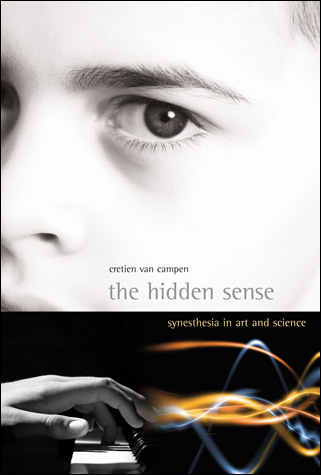
order your book reviews endorsements blogs & discussions interviews
What is does it mean to hear music in
colors, to taste voices, to see each letter of the alphabet as a different
color? These uncommon sensory experiences are examples of synesthesia, when two
or more senses cooperate in perception. Once dismissed as imagination or
delusion, metaphor or drug-induced hallucination, the experience of synesthesia
has now been documented by scans of synesthetes' brains that show "crosstalk"
between areas of the brain that do not normally communicate. In Synesthesia
in Art and Science, Cretien van Campen explores synesthesia from both
artistic and scientific perspectives, looking at accounts of individual
experiences, examples of synesthesia in visual art, music, and literature, and
recent neurological research.
Van Campen reports that some studies define synesthesia as a brain impairment, a
short circuit between two different areas. But synesthetes cannot imagine
perceiving in any other way; many claim that synesthesia helps them in daily
life. Van Campen investigates just what the function of synesthesia might be and
what it might tell us about our own sensory perceptions. He examines the
experiences of individual synesthetes--from Patrick, who sees music as images
and finds the most beautiful ones spring from the music of Prince, to the
schoolgirl Sylvia, who is surprised to learn that not everyone sees the alphabet
in colors as she does. And he finds suggestions of synesthesia in the work of
Scriabin, Van Gogh, Kandinsky, Nabokov, Poe, and Baudelaire.
What is synesthesia? It is not, van Campen concludes, an audiovisual
performance, a literary technique, an artistic trend, or a metaphor. It is,
perhaps, our hidden sense--a way to think visually; a key to our own
sensitivity.
6 x 9 inch, 208 pp., 44 illustrations, including color illus..
$29.95/£19.95 (CLOTH)
ISBN-10:0-262-22081-4 ISBN-13:978-0-262-22081-1
Order your book from:
Reviews
" In keeping with Leonardo's mandate to foster the exchange between the arts
and scientific investigation, The Hidden Sense explicitly considers the
implications of aesthetic experience in general and of twentieth-century
audiovisual media in particular for the manner in which we define and
distinguish the senses."
Robin Curtis, in Senses & Society, 2011, Vol.6, issue 2, pp. 236-239
"The Hidden Sense by Cretien Van Campen and The Frog Who Croaked Blue by
Jamie Ward are the latest instalments in a rapidly growing series of scientific
and popular writings on a fascinating condition known as synaesthesia. […] In
summary, we think both of these books will be an interesting and illuminating
read for synaesthesia researchers, students and lay readers who are interested
in learning more about synaesthesia. The two books, shaped by the different
forms of expertise possessed by the two authors, complement one another and
afford a synergy of understanding for those who have the pleasure to read these
important contributions."
Daniel Smilek and Mike J. Dixon, in
Trends in Cognitive Sciences 2008, Vol.12 No.10, p. 364-366.
This slim volume provides a good introduction to the fascinating phenomenon
of synaesthesia in art and science. It is too brief an account to dig deeply
into this complex area, but it does offer a wide-ranging and summative overview,
from the accounts of synaesthetes themselves to the findings ofcognitive and
neuroscientific research.
Simon Shaw-Miller, in
The Art Book 2009, vol. 15, issue 14, p. 75
"This intriguing book is composed of a well organized reader-friendly text
and it greets its audience with a concise table of contents that informingly
guides the reader as soon as the reading journey starts. [...] This book with
its analytical approach to this phenomenon, reports of experiments,
illustrations, diagrams, theoretical information, personal synesthetic
experiences will appeal to psychologists, neurologists, artists,
instructors,child specialists, parents, musicians, software writers,
mathematicians. Futhermore the book will definitely make the reader
“look-see-smell-touch-feel” twice."
Necla Çıkıgil, in
Consciousness, Literature and the Arts, April 2008.
"The Hidden Sense: Synesthesia in Art and Science, by social scientist
Cretien van Campen, is a straight-forward, readable account of a perceptual
condition in which sensory modalities are crossed - for instance, when music and
other sounds are experienced as colors."
Nancy Princenthal, "Art and Science, On Speaking Terms", in
Art
in America, April 2008, pp. 45-56.
"Van Campen has succeeding in writing a book that has
quite literally changed the way that I think about the world. His careful
exploration of the condition of synesthesia - incidentally, he is a
synesthete - unearths a new and strange world of experience that most people
cannot access. By taking the time to explain the complexities of the condition
in all of its different manifestations, The Hidden Sense offers a
tantalising glimpse into a previously inaccessible world of experience."
Tim Roberts in
Media & Culture Reviews
“Strongly relying on the latest scientific experiments
(brains scans) as well as on a lifelong personal research on and with
synesthetes (persons being able of synesthetic perception), the author manages
to offer a discussion of synesthesia that is of interest for the specialists as
well as for the broader public. […] The author’s way of arguing finds always a
good balance between direct experience (the testimonies of the many synesthetes
with whom he has been working for many years now) and the scientific results of
cognitive and neuroscientific research (of which he is able of giving very clear
and readable reports and syntheses).”
Jan Baetens, Professor of Literary Studies at the Leuven University, Belgium
in
Leonardo, January 1, 2008
"Van Campen is a social scientist with some synaesthesia,
who has thought deeply about the phenomenon, read widely, consulted leading
scientists, and interviewed and tested ordinary and artistic people with many
types of synaesthesia. 'Cases have been reported of
synaesthetes who feel coloured pain, hear odours, hear tastes, taste sounds,
feel sounds on their skin, hear images, and taste images',
van Campen explains. He delves into this complexity with authority, subtlety,
and charm, and the result is a generally accessible, concisely written, and
thoughtprovoking read."
Andrew Robinson in
The Lancet, December 1, 2007
"In The Hidden Sense, Cretien van Campen, a self-styled naturalist of
synaesthesia, explores this ground, providing a gentle, insightful,
often personal, account of coloured words, smells, tones, pains, even orgasms,
that will fascinate scientists, artists, synaesthetes and
others. Slowly, this deep, seemingly intractable, subjectivity yields to some
phenomenology, simple questionnaires, elegant experiments, a
dash of neuroimaging, and much thought and reflection."
Chris McManus, Professor of Psychology and Medical Education at University
College London, in
NATURE, November 1, 2007
Endorsements
"Even readers already familiar with synesthesia will find much to learn from
Crétien van Campen's The Hidden Sense: Synesthesia in Art and Science. In
clear and lucid prose, van Campen provides shimmering descriptions of
synesthetic experiences as he explores the complex interplay between synesthesia
in science and, especially, synesthesia in the arts. Although several of van
Campen's stances on the science of synesthesia are debatable and controversial,
agree with them or not, reading The Hidden Sense will broaden and deepen
one's understanding of this fascinating set of phenomena."
Lawrence E. Marks, Director, John B. Pierce Laboratory, and Professor of
Epidemiology and Psychology, Yale University
"This is an extremely interesting, current, and well-written book that
highlights a fascinating topic in synaesthesia research, namely the translation
of synesthetes' experiences into art."
Hinderk Emrich, Department of Psychiatry and Psychotherapy, Hannover University,
Germany
"This slim, sparkling, sonorous volume is wonderfully rich and
attention-holding. The Hidden Sense will be of profound interest to
cognitive scientists, musicians, and other artists for the dialogue it enjoins
between their respective domains of expertise. But it will especially appeal to
the general reader for the lucidity of its exposition of the art and science of
synesthesia, and the lively accounts it contains of the everyday experience of
synesthetes in their own words."
David Howes, Department of Sociology and Anthropology, Concordia University
Blogs & Discussions

The
New England based radio station WICN dedicated a radio
show to the subject of
Art
and History, Art and Neurology, including a 30-minute
interview (10MB, mp3 or stream) with Cretien van Campen on his book
The Hidden Sense:
Synesthesia in Art and Science.
|
||
George Baker is the author of
The Artwork Caught by the Tail: Francis Picabia and Dada in Paris.
|